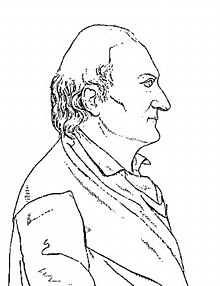
Summary
Alberto Fortis[a] (1741–1803) was an Italian writer, naturalist and cartographer, citizen of Republic of Venice.

Life edit
His real name was Giovanni Battista Fortis[1] (his religious name was Alberto[2]) and he was born in Padua on either 9 or 11 of November 1741. He journeyed extensively in Venetian Dalmatia. His best known work is Viaggio in Dalmazia ("Journey to Dalmatia"), originally published in 1774 and first published in London in 1778.[3][4]
The highlight of the book is the description of Morlachia, a historical region currently located in Croatia named after the Morlachs that inhabited the region. In his book, Fortis presented his literary discovery "Hasanaginica" as a Morlach (Vlach) ballad. Larry Wolf believed Fortis wrote the ballad as a poetry of South Slavs rather than a poetry of the Morlachs.[5] Fortis believed that the Morlachs preserved their old customs and clothes. Their ethnographic traits were traditional clothing, use of the gusle musical instrument accompanied with epic singing. He also published several specimens of Morlach songs. Fortis noted that the Slavic-speaking Morlachs called themselves “Vlachs”, but refuted the assumption that they might be related to the Latin-speaking Vlachs.
Alberto Fortis's account of the Morlachs, translated into French, English and German brought the Morlachs to the attention of Europe.[6] This started a new literary movement known as Morlachism.[7]
The Croatian writer Ivan Lovrić, who wrote Osservazioni di Giovanni Lovrich sopra diversi pezzi del viaggio in Dalmazia del signor abbot Alberto Fortis coll'aggiunta della vita di Soçivizça ("Observations of Giovanni Lovrich [Ivan Lovrić] on several pieces of the journey to Dalmatia of Mr. Abbot Alberto Fortis with the addition of the life of Soçivizça"), accused Fortis of many factual errors, which he attempted to rectify.[8] Travels into Dalmatia played an important role in bringing the Dalmatian culture to the attention of Europe during the rise of Romantic notions about folklore. Dalmatian hinterlands became epitomized by Hasanaginica, a folk ballad that was first written down by Fortis.[9]
In 1795 Fortis was elected Fellow of the Royal Society in London. He died in Bologna eight years later on 21 October 1803.[3]
Works edit
This list is incomplete; you can help by adding missing items. (September 2011) |
- Fortis, Alberto (1778). Travels into Dalmatia; containing general observations on the natural history of that country and the neighboring islands; the natural productions, arts, manners and customs of the inhabitants: in a series of letters from Abbe Alberto Fortis. London: J. Robson. OCLC 4895425.
- Fortis, Alberto (1786). A poetical sketch of the revolutions that have happened in the natural history of our planet: intended as a specimen of a philosophical and theological poem. London: B. White. OCLC 642418397.
Notes edit
- ^ Also known as Abbe Alberto Fortis. and also Abate Alberto Fortis. Abate is an Italian spelling of Abbe (Name Origin Research staff 2011)
References edit
- ^ International Musicological Society Congress 1990, p. 1454.
- ^ International Musicological Society Congress 1993, p. [page needed].
- ^ a b Ciceran 2011.
- ^ Addison's Rare Books & Bindery.
- ^ Wolff 2003b, p. 44.
- ^ Wolff 2003b, p. 41.
- ^ Milić Brett, Branislava (2014). Imagining the Morlacchi in Fortis and Goldoni (PhD). University of Alberta. pp. 1–213. doi:10.7939/R3MM45.
- ^ Maggs 1989, pp. 546–563.
- ^ Wolff 2003a, pp. 191–192.
Bibliography edit
- Addison's Rare Books & Bindery, 1774. Viaggio in Dalmazia. 1st Edition with 15 folding plates. Very Rare, OneRareBook.com, retrieved 26 September 2011
- Ciceran, Marisa (22 September 2011) [2008], Alberto Fortis, Istria on the Internet, retrieved 29 September 2011
- Fortis, Alberto (1778), Travels into Dalmatia; containing general observations on the natural history of that country and the neighboring islands; the natural productions, arts, manners and customs of the inhabitants: in a series of letters from Abbe Alberto Fortis., London: J. Robson, OCLC 4895425
- Fortis, Alberto (1786), A poetical sketch of the revolutions that have happened in the natural history of our planet : intended as a specimen of a philosophical and theological poem, London: B. White, OCLC 642418397
- International Musicological Society Congress (1990), Kongressbericht, vol. 3, Bärenreiter
- International Musicological Society Congress (1993), Actas del XV Congreso de la Sociedad Internacional de Musicología: culturas musicales de Mediterraneo y sus ramificaciónes, Madrid/3-10/IV/1992, La Sociedad
- Maggs, Barbara W. (October 1989), "Three Phases of Primitivism in Portraits of Eighteenth-Century Croatia", Slavonic and East European Review, 67 (4): 546–563
- Name Origin Research staff (2011), Last name: Abate, Internet Surname Database, retrieved 26 September 2011
- Wolff, Larry (2003a), Venice and the Slavs: The Discovery of Dalmatia in the Age of Enlightenment, Stanford University Press, pp. 191–192, ISBN 0-8047-3946-3
- Wolff, Larry (2003b), Rise and fall of Morlachismo.In: Norman M. Naimark, Holly Case, Yugoslavia and Its Historians: Understanding the Balkan Wars of the 1990s, Stanford University Press, pp. 40–46, ISBN 978-0804745949
External links edit
- Works by Alberto Fortis at Project Gutenberg
- Works by or about Alberto Fortis at Internet Archive


